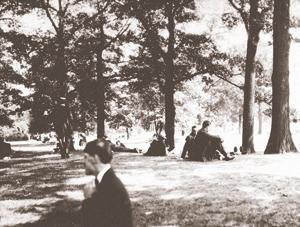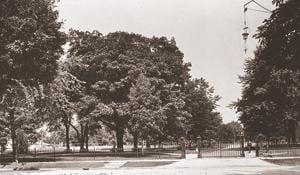
Men in Queen's Park, 1912. Credit: City of Toronto Archives
As Pride approaches and we gear up for the parades, the parties and the protests, we shouldn’t forget about the past. Linking queer politics with the queer past has always been key to our movements. Over the years, Xtra has devoted significant space to queer history. As a historian, I’ve been fortunate to share in that space. Back in 1996, I contributed a three-part series on the history of men who had sex with men in early 20th-century Toronto. I’m very pleased Xtra is reaching into its archives to revisit the series so it can be shared with a new audience.
The series looks at how and why men searched for sex in the city’s public places, as well as at men’s inevitable clashes with the police. Each installment explores a different urban space: parks, lavatories and laneways. The historical experiences of the men I wrote about in 1996 remain the same, of course. What has changed is the context in which we read those stories.
Back in 1996, my focus on public sex and the police emerged from what I discovered in the historical sources, but also out of my own political interests and involvement. In the early- to mid-1990s, policing was very much on our minds, be it in debates over the wisdom of police-community liaison committees or the actual policing of sex. In 1992, for instance, I remember the raucous, late-night protest against the Toronto police seizure from Glad Day Bookshop of the lesbian porn mag Bad Attitude. Carrying signs that read “Censorship sucks” and “Cops have Bad Attitude,” our no-police-permit march was led by the fiery Sue Golding, who rallied us with her cry: “Tonight, the streets belong to us!” And in the same year my Xtra series appeared, the police raided Sperm Attack Mondays, the short-lived jack-off contest I attended at Remington’s strip club.
As we know, the policing of public sex hasn’t disappeared. So how, then, has the context changed? Re-reading these tales from the sexual underground, they still scream police, but I’m struck by how they also speak to new issues. Take, for example, the much-discussed fear over the demise of the Church-Wellesley Village. Researching Toronto’s queer past has shown me that efforts to mark out and maintain spatial borders around urban queer life are not only arbitrary and often exclusionary, they also rub up against the reality that, historically, men (along with many others) have not restricted themselves to any single area in the city. As we’ll see, men’s appropriation of back alleys and bushes in every corner of early 20th-century Toronto testifies to a refusal to be cornered. Should the day come Church and Wellesley does disappear, it will be only the latest moment in the history of a transient queer sex that refuses to be fenced in.
Another thing that sticks out re-reading these stories years later is all the sex. It’s a stark contrast to much queer culture these days, in which fetish fairs become family fun days — goodbye dungeons, hello bouncy castles — and we now do the dirty work for the police. Just a few months ago, Winnipeg’s queer magazine, OutWords, stopped running sexually explicit ads to avoid offending consumers in upscale markets. But the queer past will not be so easily cleaned up. In the stories that follow, the “slimy penises,” all the pesky “erections,” stand as a historical challenge to the forces currently trying to contain the irrepressible erotic energy of queer culture.
The repeated references to “his privates” and “his person” also remind us that these are historical stories about men. They are a relatively diverse group — middle-class and working-class, anglo and immigrant — but men nonetheless. And yet, as Bad Attitude and the Pussy Palace remind us, public sex has never been the sole preserve of men, and I hope these forays into queer men’s pasts encourage others to further excavate the histories of lesbians, trans people and other sexual dissidents. For if there’s one thing I’ve learned doing historical research, it’s about the queer past’s capacity for reinvention, its power to intervene in the queer-and-now in new and novel ways.
Long before bathhouses and sex clubs, men cruised Toronto’s parks in search of sex with other men. And long before the 1981 bathhouse raids, the Toronto police patrolled the city’s sexual spaces, arresting men.
In researching my book on men who had sex with other men in the early 20th century, many questions intrigued me. Where did men meet? How did they hook up and what kind of sex did they have? Were they able to circumvent the policing of sex? To find some answers, I turned to criminal court records for the years 1890 to 1940. In the early part of the 20th century, all sexual relations between men were illegal, whether they were in public or private, no matter what the ages of the parties involved. As a result, many men were arrested, charged with offences such as “buggery” and “gross indecency,” and prosecuted. The transcripts of their trials — the testimony of both the men who had sex with other men and those who policed such activity — provide much detail on homosexual activity.
The legal records revealed a host of different urban spaces where men met for sex. Of course, public spaces were not the only places men found each other. It depended on the individual man and his circumstances. A middle-class man of means, for example, might have the luxury of privacy and be able to entertain other men in his own apartment. But for most in early 20th-century Toronto, privacy was in short supply. Many were married with families and so might be unable to invite men back to their homes. And while some working-class and immigrant men found each other in the boarding houses where they roomed, it was often too risky while under the watchful eye of the house’s keeper for one man to bring another back to his room.
So, for many, it was necessary to leave home and venture out into the city’s sexual underworld in search of other men. Undoubtedly, others pursued sex in public places not so much out of necessity, but because it suited their erotic interests.
Sex in Toronto’s parks occurred most often late at night, under the cover of darkness. On the evening of May 23, 1913, George C and George J were out walking after midnight in Memorial Square Park, at the corner of Portland and Wellington streets. As a police constable testified before the Toronto Police Court, “I saw George C laying on his right side with George’s face in his crotch. I watched there awhile. George J ordered George C to keep his leg higher up. When within 20 feet, George J got up. George C was laying on the ground with his pants open, his shirt up, his penis was slimy and had an erection.” The constable arrested the two Georges, escorted them to the patrol wagon and took them to the station.
In addition to Memorial Square, two of Toronto’s central parks — Allan Gardens and Queen’s Park — were popular sites for sexual encounters. Both parks were heavily treed, providing a convenient cover for cruising. Parks associated with amusement areas, such as Sunnyside Beach and the Exhibition grounds, were also frequented by men looking for sexual space. During the 1913 Canadian National Exhibition, two young labourers, aged 18 and 19, were caught having sex. As the man who stumbled upon them explained, “I was at the Exhibition on Sept 3 [when] at the rear of the fire hall I saw James C having Charles W’s person in his mouth.”
At times, the parks became rather busy sites of homosexual activity. As one constable testified in court, while patrolling Queen’s Park “about 11:10pm one Saturday [I] heard a sound like sucking.” He explained that not only did he observe a man “lying on his back and another man . . . kneeling with his mouth towards [his] privates,” but beyond these men, behind a tree, there was “another couple who were there.”
Many encounters were anonymous, one-time affairs. As Henry B told the court about his sexual partner, “I have never seen this man before.” For others, public sex was a more frequent feature of their sexual lives. For them, the sexual underground could be a place of familiar rather than anonymous encounters. In 1908, Alfred J got caught with his pants down in Queen’s Park. Of the person he had sex with, Alfred told the police that “he had met this man on a previous occasion.”
Whether it was a one-time foray or a recurrent element in their sexual lives, men having sex in the parks had to be very careful. Police regularly patrolled these areas. And yet, while the police caught many men, not all were successfully apprehended. Some managed to get away. Explaining to the court why only one of two men he found having sex in the park appeared for trial, one police constable said, “The other man got up and ran away.” Another case file noted simply that the “co-offender escaped.”
In the decades before gay bars and baths, men claimed the city’s public parks for their own sexual purposes. They did so at great risk and always in contestation with the forces of sexual policing. In my next article, we’ll take a tour through another layer of the sexual underground: Toronto’s early 20th-century tearooms.

 Why you can trust Xtra
Why you can trust Xtra


